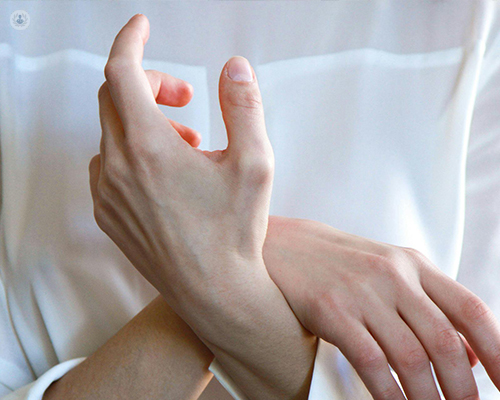Getting a grasp on Dupuytren's contracture
Escrito por:If you are struggling with your fingers bending in and stubbornly refusing to budge, it’s not that they’re mutinous nor developing a mind of their own. You might be dealing with Dupuytren’s contracture, a chronic condition that causes the fingers to freeze in place. An esteemed orthopaedic surgeon explains how the condition happens and the options for treatment.

What is Dupuytren’s contracture?
Dupuytren’s contracture is a condition of the hand where the fibrous tissue, called the palmar fascia, that sits under the palm begins to grow hard lumps and toughens in texture, and this can be felt from the surface of the palm. The palmar fascia is the anchor point for the tendons of the hand, helping them stay in place, but when the lumps grow bigger and start to form cords that tighten, this causes the fingers to permanently curl inwards, obstructing the use of the fingers and other flexible parts of the hand. The little and ring fingers tend to be the most affected, but it can occur in all of the fingers. It can happen on only one hand, but it is more common to have it in both hands, which will obviously affect functionality.
What causes Dupuytren’s contracture?
There are no definitive causes for Dupuytren’s contracture, but it is thought to be passed down genetically. There are higher instances of this condition in men of European descent, and it is most common in older people.
The condition will worsen over time, and leave the fingers frozen in bent and crooked positions. It would be very difficult to straighten the fingers in the advanced stages, even with the use of force and splints.
Although this condition is not life-threatening or painful, it can severely disrupt daily life, and thus can have a mental toll on the patient. Everyday activities such as driving, writing or drawing, typing, using cutlery, and getting dressed may eventually be impossible without assistance.
How can Dupuytren’s contracture be treated?
If noticed in the earliest stages where the finger is only slightly bent, a full correction can be done with surgery. For more extreme cases, surgery can only improve the positioning of the fingers, but will not be able to straighten them completely. This procedure, called Dupuytren’s fasciectomy, involves the removal of the thickened cords of tissue via an incision to the palm.
Surgical treatment is, however, temporary, as it will not stop the hardening of the palmar fascia and the fingers may start to curl in again within two years after the surgery. For reoccurrences, a similar surgery can be conducted called a demo fasciectomy, where the cords are replaced with a skin graft. But again, it is important to note that this is still not a permanent cure and there is not guarantee that the cords will not thicken once more.
An alternative treatment is collagenase, which would be injected into the thickened tissue to break up the chords and allow them to be stretched, releasing the fingers from their long-held position. Unfortunately, this treatment is no longer available in the UK and Europe.
If you have concerns about the condition of your fingers, hands, or wrists, consult with a specialist today via Top Doctors.


